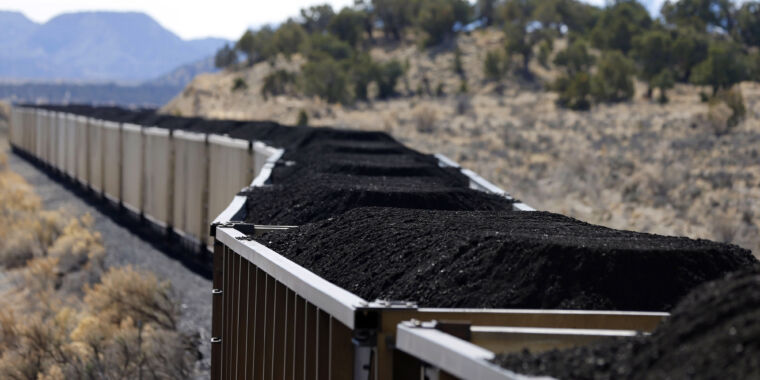Although coal consumption in the United States has fallen significantly since 2005, the country still burns millions of tons of coal annually and exports many more tons, much of it transported by rail. Now, a new study finds that this could have health effects on people who live near where those rail lines pass.
The study found that residents living near railroad tracks were more likely to experience premature deaths due to air pollutants released when open-air coal trains passed by. An analysis of the San Francisco Bay Area cities of Oakland, Richmond, and Berkeley found that increases in air pollutants such as fine particulate matter (PM 2.5) were also associated with increased asthma-related attacks and hospitalizations.
“This has never been studied anywhere in the world. There have been some studies before that have tried to measure just air pollution, usually in rural areas, but this is the first time they’ve measured both air pollution and trains in urban areas,” said study author Bart Ostro, an epidemiologist at the University of California, Davis.
Persistent coal pollution
About 70% of coal shipments in the United States are carried by train, which releases pollutants during transportation. Coal exports have a similar impact during transportation. Ostro explained that when coal trains run without a roof, coal particles are dispersed around the tracks. PM2.5 levels are “[spread] It’s about a mile away,” he added.
As a result, the mere passage of a coal train can impact the health of the surrounding community. Ostro is particularly concerned about how these pollutants could harm vulnerable residents who live near Richmond’s coal export terminal. Previous census data has already shown that people living along Richmond’s rail line have a mortality rate 10 to 50 percent higher than the county average. Oakland communities could also be at risk, as discussions are underway to build a new coal export terminal in the area.
But before researchers could study the health effects of these air pollutants, they first needed to understand how much was being spread by passing trains, which was a challenge in itself, since coal trains don’t run on a set schedule like regular passenger trains.
To enable researchers to measure all trains and pollutants, Ostro and his team developed a monitoring system with three main components: a weather station to provide meteorological parameters, an air quality sensor to track air pollution levels, and an AI-trained camera to recognize coal trains. The trained camera is critical to the entire project, identifying different types of trains, including full coal trains, empty coal trains, freight trains, and passenger trains.
With the system in place, Ostro’s team was able to measure pollution levels and identify them as directly attributable to coal trains. Results published last year showed that coal trains and terminal operations contribute significantly more PM2.5 pollution to urban areas than other freight and passenger trains. Passing coal trains averaged 8μg/m3 This leads to air pollution – 2-3 micrograms more than a freight train emits – and even empty coal cars raise pollution levels with tiny amounts of coal dust.
Particulate matter issues
In a follow-up study this year, researchers combined these findings with U.S. Census data and health surveys to understand how this increase affects communities. They estimated that more than 260,000 people are exposed to increased PM2.5 annually, and that such exposure translates into significantly increased mortality and morbidity.
Health effects were quantified under three different scenarios based on different wind conditions. In the worst-case scenario, the average exposure was about 2 μg/m3 Premature mortality is modeled to increase by 1.3 percent along rail lines. Hospitalizations for conditions such as chronic lung disease, pneumonia, and cardiovascular disease are also increased by 4.7 percent, 6.2 percent, and 2.2 percent, respectively. These are relatively small numbers for a small population, but Ostro points out they can be extrapolated to other countries with larger populations.
“In my view, this is a microcosm of what could happen around the world,” he added. While coal use and transportation is declining in the United States and the European Union, that’s not happening everywhere. For example, coal use is increasing in countries such as China and India, which could put residents living near railways that transport coal at risk.
“The findings have far-reaching implications beyond San Francisco and the United States,” said Michelle Abramson of Monash University in Australia, who was not involved in the study. She believes Ostro’s assessment “fills an important gap” by looking at the health effects of transporting coal in open rail cars, but sees no solutions to mitigate the problem other than stopping coal use.
“Covering coal cars may not solve the problem, as they could increase the risk of fire,” he added. “Ultimately, the world needs to phase out the mining, transporting and burning of coal, not just to reduce the risks of climate change, but also to improve people’s health.”
Environmental Studies, 2024. DOI: 10.1016/j.envres.2024.118787
Bárbara Pinho is a science journalist specializing in climate, health and agriculture based in Porto, Portugal. Find out more about her work at Barbara Pinho Or follow her on X (formerly Twitter) @BarbPinho


